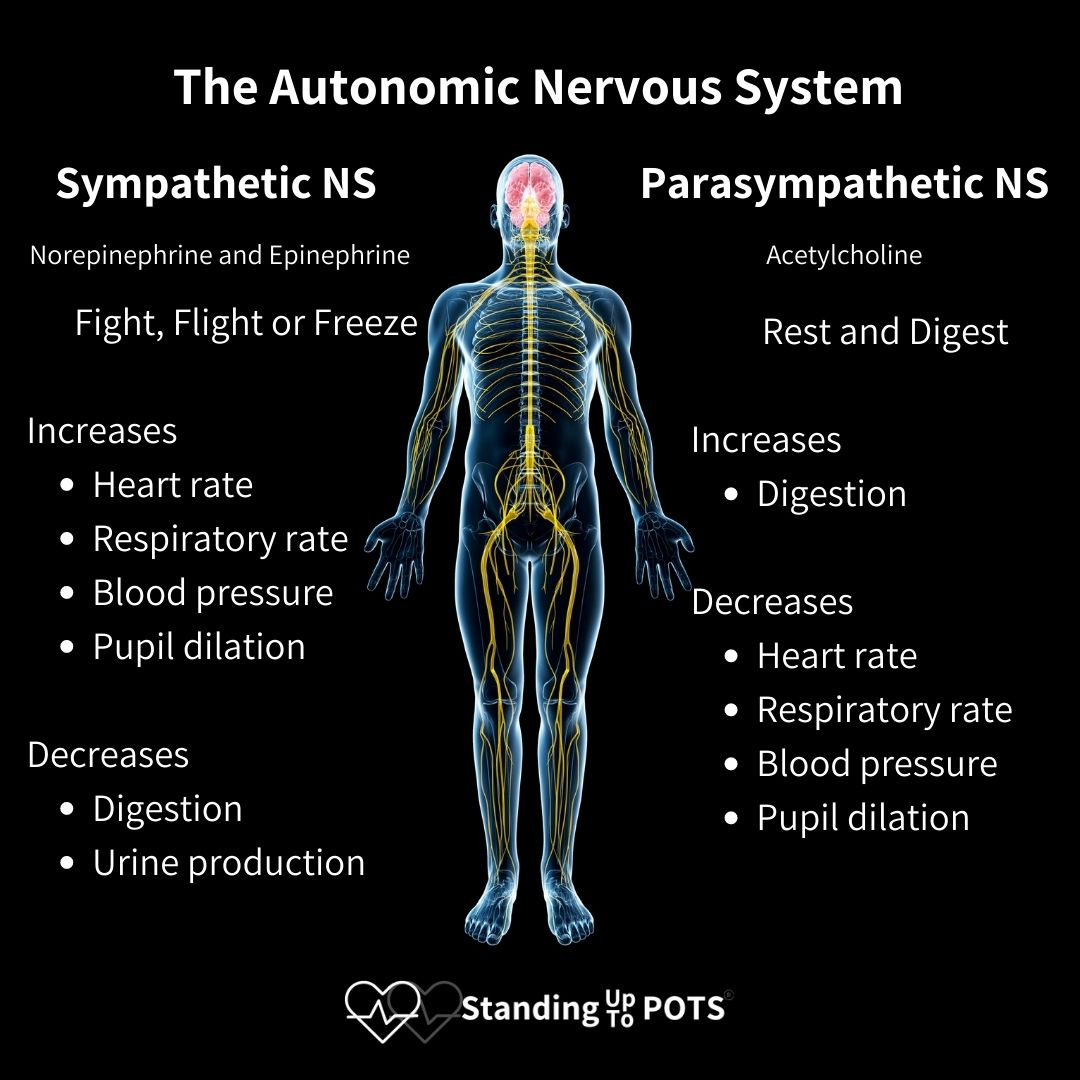Autonomic Nervous System 101
How does this relate to POTS?
POTS is the most common form of dysautonomia, which means that your autonomic nervous system – the automatic control for many involuntary functions like digestion, heart rate, blood pressure, etc. – is malfunctioning. The autonomic nervous system is divided into two main subdivisions: the sympathetic nervous system and the parasympathetic nervous system.
The Sympathetic Nervous System: Fight, Flight or Freeze
The sympathetic nervous system helps us deal with real or perceived danger. When activated, the sympathetic nervous system causes the release of two neurotransmitters, norepinephrine and epinephrine, and helps your body get ready for its fight or flight response. To get more blood and oxygen to your muscles, the sympathetic nervous system increases your heart rate, blood pressure and respiratory rate. It also decreases blood flow to organ systems not involved in that fight or flight response like digestion and urine production. The sympathetic nervous system will often start this response, but it can be prolonged by release of norepinephrine and epinephrine from the adrenal gland.
The Parasympathetic Nervous System: Rest and Digest
The parasympathetic nervous system, by contrast, helps the body with normal functions that maintain homeostasis within the tissues. The parasympathetic nervous system releases a different neurotransmitter, acetylcholine, to help your body to rest and digest. This system increases digestion, and decreases heart rate, blood pressure, and respiratory rate, so it has the opposite function from the sympathetic nervous system. The parasympathetic nervous system is largely mediated by the largest cranial nerve, the vagus nerve, which helps to regulate the function of many internal organs and controls digestion, heart rate, and respiratory rate.

Dual Innervation at Most Organs
The sympathetic and parasympathetic nervous systems both go out into the periphery (away from the brain and spinal cord) and regulate many involuntary bodily functions. Most organ systems receive information from both the sympathetic and parasympathetic nervous system, including the heart, lungs, and digestive tract.
Let’s think about heart rate as an example. The sympathetic nervous system releases norepinephrine at the sinoatrial node (pacemaker of the heart), while the parasympathetic nervous system releases acetylcholine in the same area. How fast your heat beats depends on the balance of these two neurotransmitters. If there’s more norepinephrine (sympathetic) than acetylcholine (parasympathetic), then your heart rate increases. If more acetylcholine is released than norepinephrine, then your heart rate slows.
Overactive Sympathetic Nervous System in POTS patients
The sympathetic nervous system's fight-or-flight response has significant overlap with POTS symptoms.
Typical POTS Symptoms that Match the Sympathetic Nervous System
- Tachycardia: Rapid heart rate above 100 beats per minute at rest
- Rapid respiratory rate
- High blood pressure (hypertension)
- Increased pupil diameter (hypersensitivity to light)
- Digestive problems: Rapid gastric emptying or gastroparesis
When the autonomic nervous system malfunctions as it does in POTS, there is too much release of norepinephrine and epinephrine from the sympathetic nervous system and/or too little release of acetylcholine from the parasympathetic nervous system, causing these symptoms.
For people who have the hyperadrenergic subtype of POTS, this imbalance and sympathetic overdrive is even bigger. These prolonged sympathetic bursts wreak havoc on the body and the mind, increasing blood pressure, causing damage to blood vessels, and causing restlessness and that jittery feeling.
Treatments as They Relate to the Autonomic Nervous System
There are two main approaches to treating POTS symptoms resulting from this autonomic imbalance. One is to decrease the activity of the sympathetic nervous system, and the other is to increase the activity of the parasympathetic nervous system. In many cases, physicians prescribe medications that do both.
There are medications that decrease the activity of the sympathetic nervous system directly. Beta blockers, like propranolol, fit into this category as they block the norepinephrine receptor (remember that norepinephrine is the neurotransmitter of the sympathetic nervous system) on the heart. As these receptors are blocked, the heart rate slows back down to more normal levels. A second example would be the centrally acting sympatholytic drugs, like clonidine, which actually block the release of norepinephrine in the first place. In both cases, the sympathetic overdrive is slowed which can decrease heart rate, respiratory rate, etc.
The other major approach is to increase the activity of the parasympathetic nervous system. Acetylcholinesterase inhibitors, like pyridostigmine, increase the acetylcholine levels in the brain by preventing the normal breakdown of acetylcholine. This prolongs the activity of the parasympathetic nervous system and also can slow the heart rate, respiratory rate, etc.
For more information, listen to The POTScast, Episode 4: Autonomic Nervous System 101 with Dr. Cathy Pederson